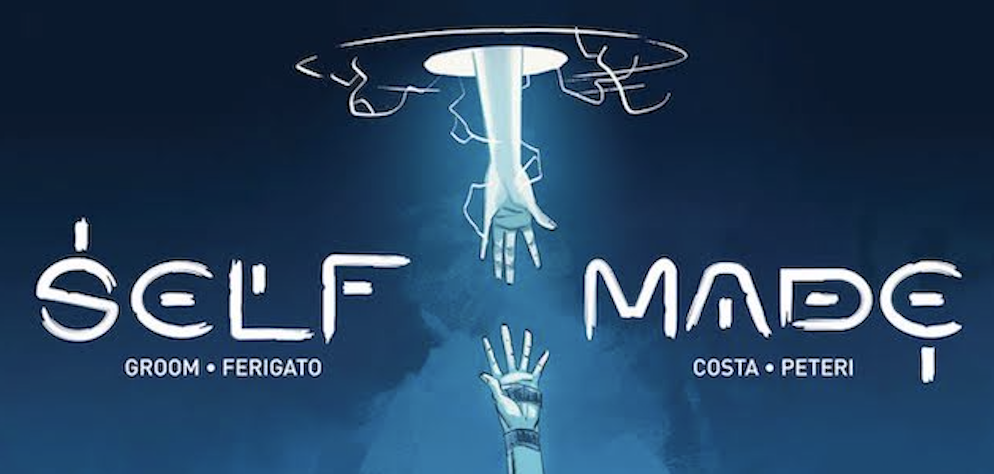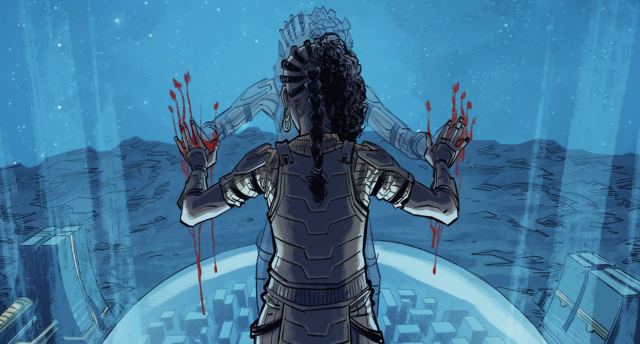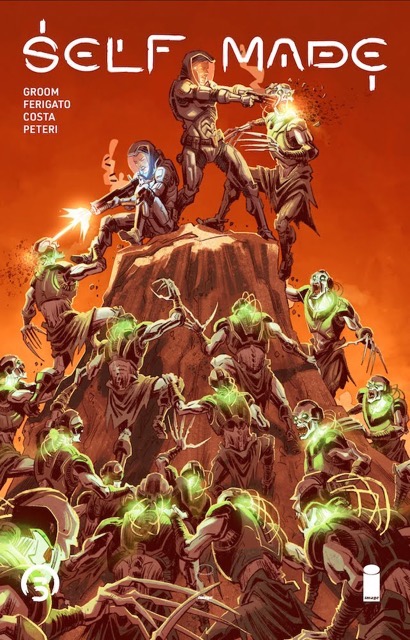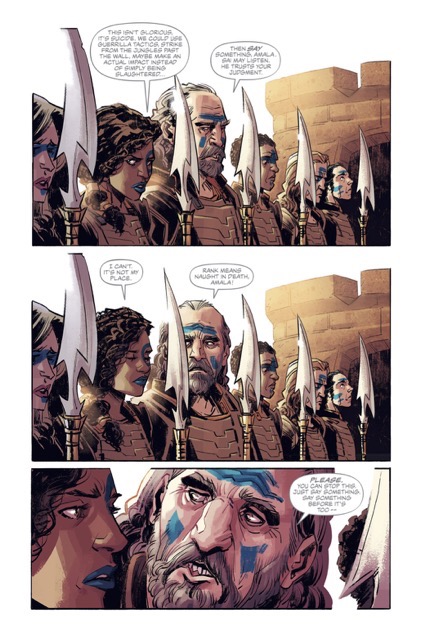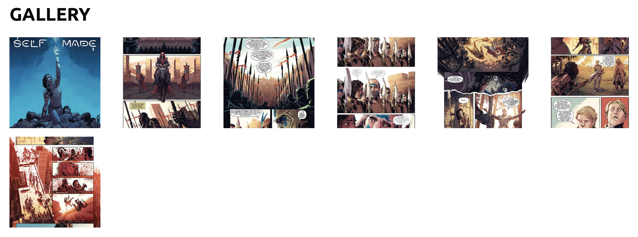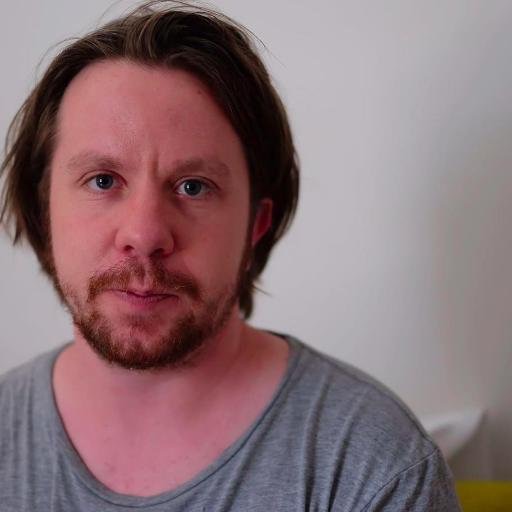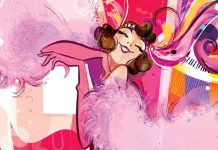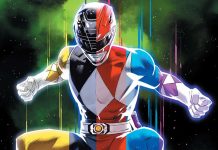One of the things I liked most about the first issue of SELF/MADE is how it hints about the strange world Amala inhabits until the last page brings everything to a head, giving us a clearer idea of where the story is going. You can’t discuss that revelation and what comes after in an interview promoting the upcoming first issue, so I asked if Mat Groom would like to talk again because there’s so much more to discuss. I was grateful he was interested and am excited to share our conversation about the future of SELF/MADE and Mat as a storyteller.
Spoilers ahead.
All art by Eduardo Ferigato and Marcelo Costa
SELF/MADE releases just over a month after the debut of Red Dead Redemption 2. Did news of its development influence how you approached realistic video game characters?
Nah, SELF/MADE’s been in development for too long for that particular bit of news to have influenced me. But I think the central issue there—the insane workloads and schedules and expectations imposed on people working at these bigger developers–that’s not a new issue, and that’s absolutely going to factor into the narrative of SELF/MADE.
I’ve always been fascinated by the creative process, and how it connects to commerce… and the video game industry is just an insanely proportioned model of that interaction.
I mean, in comics—there are 7 people listed on the credits page for SELF/MADE, right? There are maybe two more people from Image HQ– Deanna Phelps, a production artist, and Melissa Gifford, who’s a content manager– who have a direct impact on what goes to press. So that’s nine people. And because of that, I feel quite a bit of pressure. I feel I need to be producing work to a standard that does justice to the contributions of 8 talented professionals. And I especially feel pressure to deliver for the sakes of those members of the team with an ownership stake in the book.
I can’t imagine the pressure of having hundreds and hundreds of salaried employees on my team. Having people who are counting on you to release a work of art that earns, literally, over a billion dollars. And with that hanging over your head, you’d also have to have that small voice in the back of your mind reminding you that you’re trying to clear that bar with a product that is entirely subjective. A product that’s going to judged by consumers on the basis of taste, and ineffable cultural movements, and the other art that’s been developing in parallel to what you’ve been creating… oof. Yeah. That’ll have an impact on a person. And it will, in our story.
Did any other video games help shape SELF/MADE?
I wish I could point you to something specific, but… not really, if I’m honest. It really is just a product of Eduardo and I’s thoughts about games in general and sort of… well, no pun intended, but gaming out where the industry might be headed and how our world might evolve alongside that development.
I can say, though, that there was one game that served as a very direct inspiration– not for the story, really, but for the cover of issue #3– and that’s the original DOOM. Eduardo and I were talking about cover ideas, and he said ‘I’d like to do an homage to the box art for DOOM’ and I knew straight away where he was going with it, and, predictably, he absolutely killed it.
What was your thought process when deciding how technologically advanced to make the world outside the video game?
It was basically a process of just working backward from the core of the story, which is that someone might, in the course of creating characters for video games, accidentally create the first true artificial intelligence. Now, obviously we’re not anywhere near that yet, so we knew it’d have to be some time into our future.
From there, we thought about what kind of shape the world might be in at that point in the future, and how technology might respond to that physical and cultural environment.
Of course, there was absolutely a bit of ‘wouldn’t it be cool if they had this thing?’, ‘oh, damn, yeah it would, let’s do that’ too.
Once they’ve spent some time together, will Amala’s relationship with her creator evolve from god-to-subject into mother/daughter?
Not really, no. It will certainly become more personal, but Rebecca, Amala’s creator, wasn’t playing around with artificial intelligence because she wanted to be a mother, she was doing it because she’s an inventor and a creative. She’s not a particularly maternal person– it’s just not who she is, or where she’s headed. And Amala has a mother (not a ‘real’ one, of course, but real enough to Amala)– so there’s not really a desire for a mother/daughter relationship on either side.
But that doesn’t mean there aren’t parallels there, it’s just not as cut-and-dry as that. For example, I doubt Steve and Stan considered Peter Parker to be their son, or behaved in a way that might suggest that sort of relationship. Now, might that change if Peter Parker literally came to life? Would it become more fatherly? And if not… what, then? That’s what we’re exploring.
Amala goes through a lot in the first four issues. She goes through world-shattering existential disillusionment, and then also has to deal with some other, more immediate traumatic experiences… is she at risk for some kind of PTSD?
Uh, I guess I’d I wouldn’t say explicitly PTSD, both because that’s a profoundly complex and specific disorder that I don’t feel qualified to represent, and because what Amala goes through is not something modern medicine has had to deal with.
So, yeah, perhaps not PTSD specifically, but you’re absolutely right that she’ll be facing some extremely traumatic things in very rapid succession and that is absolutely going to make a radical and lasting impression on any sort of sentient being.
You mentioned in our previous interview that fantasy “allows us to reframe elements of our society so we can consider them from new perspectives.” How did Arcadia reframe the wider world of SELF/MADE?
I see Arcadia as an unintentional microcosm, or… simplification, perhaps, of the real world in SELF/MADE. Arcadia is classist, it’s divided, it’s socially rigid… and that is absolutely because it’s a reflection of the people who made it, and the society that they live in. Some of that is because, being traditional fantasy, it instinctually references elements of our history as a species, and these references come with a lot of societal baggage, whether we realise it or not. For example, Brycemere’s a Prince. And he’s a Prince because, fantasy, dragons… princes, right? Easy. But, of course, princes mean aristocracy, and suddenly you’ve (purely by accident) stumbled into a certain political set-up for your world,
But also, we’ll see that the real world of SELF/MADE, this version of our future… it’s not great. It’s not a dystopia, necessarily, it’s not Mad Max out there or anything, but society isn’t better off than where we’re at now. It might even be a little worse. So I think some of that, some of that cynicism and dourness and rigidity, it’s filtered down through all of the people who contributed to the game, and into Arcadia.
Do Amala’s fantasy world roots play a big role in her actions and emotions?
Very, very much so. Amala comes from a world of high fantasy– where the evil is tangible and the problems are literalised and the solution is action! If you go forward with virtue and you don’t shrink in the face of adversity, then you prevail and you right wrongs! So that’s how Amala operates.
Now, she’s not an idiot, at all, she’s actually very sharp– but she has literally been operating in a different world, with a different set of rules. So when she hits our world, and she hits our problems, ones can’t necessarily be killed with a sword or even easily quantified… that’ll be a challenge.
Eduardo Ferigato excels at making the characters feel human. Rebecca’s weariness, Bryce’s cockiness, and Amala’s fear and courage are apparent on every page. Did seeing how he interpreted your script, particularly his ability to convey emotions, influence your writing approach?
Fundamentally changed it, yeah. I wrote the script for issue 1 before Eduardo joined the team. It wasn’t written for Eduardo, at that point. But when I got those first pages back… I’ll never forget how much if floored me. He is absolutely incredible. A masterful, deeply human storyteller.
So, yeah, it changed everything about how I wrote. As soon as I saw the characters through Eduardo’s eyes, I suddenly understood much better who they were– how they spoke, how they held themselves, how they saw themselves. So it had a huge impact on how I handle the characters.
Seeing how Eduardo handled the characters and the non-verbal storytelling also gave me much-needed confidence to pull back on the dialogue and let Eduardo convey much more of the story through unspoken emotion.
That might be my one real regret about SELF/MADE so far, actually– I regret that issue 1 was written before Eduardo joined the project, and before I knew what he can do. I think issue 1, as proud of it as I am, is a bit wordy, and I think it comes through that I didn’t know how well the art would carry things. That specific sort of lack of confidence manifests itself as heavy-handed dialogue, you end up with something slightly closer to a radio play than a comic.
The other big change is that, because I know how great his storytelling instincts are, Eduardo is involved in the scripting process from the earliest stages. I’ll pitch to him the general shape of what I’m thinking, he’ll throw some ideas in, then I’ll write a script, but then he’ll take that script and change things around– even going so far as to swap pages and change scene orders– and then from that I’ll write a revised script to the layouts he’s now created, and then once I get the final art back I’ll do another pass on the script to make sure it’s speaking to Eduardo’s art. It’s a very intertwined process, I suspect it’s slightly dissimilar to a standard ‘big two’ working relationship. But it reflects his status– Eduardo isn’t the illustrator of my script… he’s the co-creator of SELF/MADE.
Troy Peteri is one of my favorite letterers and he does great work in SELF/MADE. Can you describe what your collaboration is like?
The bedrock of our collaboration and relationship with Troy is his incredible patience and unflappability.
We wanted to try a bunch of different things with the lettering in issue 1, some of it ill-advised, and Troy simply took it in his stride and just… helped guide us to where he knew we needed to be going.
Because that’s the thing about Troy. He’s just such a natural, you can’t fault his instinct. In my scripts I like to play with volume and cross-talk and strange cadence and all sorts of things that I know for a fact make a letterer’s job harder, but he handles it so deftly and seemingly-effortlessly that you don’t notice why exactly the reading experience is so evocative and pleasurable until you really look closely at the nuances of Troy’s work. All of the little moments where it breaks from standard form, it’s never ostentatious, but it’s always bespoke. It’s always is servicing a very specific type of emotion or expression.
He’s just a hell of a craftsman.
You graciously provided me with the first four issues of SELF/MADE in advance of this interview. Even though every issue is filled with story, it feels like there’s a lot more of that story to tell. How long do you hope to publish SELF/MADE?
We love SELF/MADE. We’re very proud of it, and attached to it, and, at this stage, we want to keep going for as long as we can. We have a six-issue arc which, in the unfortunate case that we’re not able to continue, will be a complete story that I think will make for a really solid trade. But, as you said, there’s so much there. We have so much more to share.
But while I have the luxury of working on the series around a full-time job, SELF/MADE is Eduardo’s full-time job– so we can only keep going for as long as we’re making enough to put food on the table in the Ferigato household.
Honestly, even if we don’t get to issue 7 in 2019, I can’t imagine Eduardo and I will be able to stop ourselves from coming back to this world (or these worlds, I guess) in the years ahead.
Now that you have a series at Image, where do you hope to go from here? Do you hope to do more and make comics a full-time occupation?
Yeah. I love it. And not in the ‘I loved that cheeseburger’ kind of way, I love it. I find it tremendously difficult but I can’t get enough of it. I’ve been reminding myself to semi-regularly stop and just soak in the feeling of how good it feels to be doing this. It’s electric. Comics, as a medium– it’s just such a primal and visceral medium for story, and the collaboration is so satisfying. It’s the best! It’s the best. I want to comics until I die.
As to where I go from here– it’s pretty loose right now. At the time of this interview, SELF/MADE #1 hasn’t come out yet, so I don’t know what the critical response will be like, I don’t know what sort of sales numbers we’ll be looking at… and I imagine that’ll play a large role in my next steps.
I’m trying to be proactive, I’ve got some pitches out… but at this point, as far as my non-SELF/MADE comics career goes, your guess is probably as good as mine.
(I’d put big money on Eduardo rapidly becoming a huge deal, though. That one’s a real safe bet.)
Follow Mat on Twitter @MathewGroom and check out SELF/MADE #1, on sale now.
Matt Chats is an interview series featuring discussions with a creator or player in comics, diving deep into industry, process, and creative topics. Find its author, Matt O’Keefe, on Twitter and Tumblr. Email him with questions, comments, complaints, or whatever else is on your mind at [email protected].


